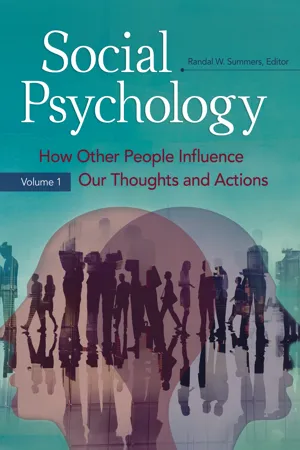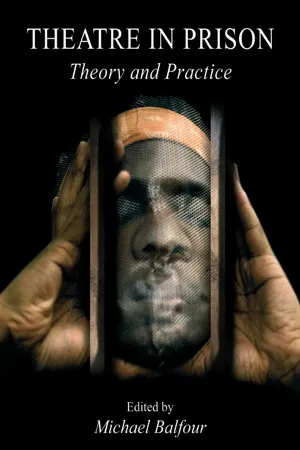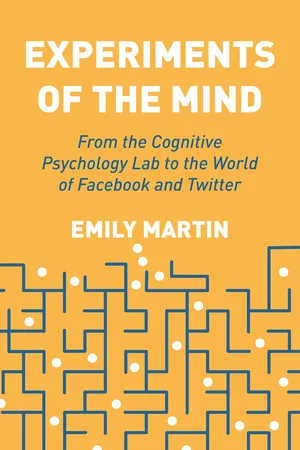Psychology
Stanford Prison Experiment
The Stanford Prison Experiment was a psychological study conducted in 1971 by Dr. Philip Zimbardo. It aimed to investigate the psychological effects of perceived power and authority in a simulated prison environment. The study famously demonstrated the potential for individuals to conform to assigned roles and exhibit abusive behavior when placed in positions of power.
Written by Perlego with AI-assistance
Related key terms
12 Key excerpts on "Stanford Prison Experiment"
- eBook - ePub
Classic Case Studies in Psychology
Fourth Edition
- Geoff Rolls(Author)
- 2019(Publication Date)
- Routledge(Publisher)
1 and his colleagues (Haney et al., 1973) began a study that drew on the previous ‘obedience’ research by Stanley Milgram (1963). The Stanford Prison Experiment (SPE) as it is now known would become almost as well known a social psychology study as Milgram’s did ten years previously. The research would question the nature of ‘evil’. Was evil behaviour due to a person’s personality or was it dependent on the situation or particular circumstances that someone faced? The basic premise was to test the ‘dispositional’ hypothesis, that the conditions experienced within prisons come about as a result of the ‘nature’ and personality of the people who populate it, be they guards or prisoners. It follows that it is these people’s personalities rather than the conditions in the prison that affect their behaviour. If it is the personality that is imported into the prison that affects behaviour then changing the conditions in the prison will not affect behaviour, whereas if there is a situational influence then changing conditions in the prison would have some positive effects. To test this ‘dispositional’ versus ‘situational’ hypothesis it would need a new prison to be set up comparable to existing prisons, but with inmates and guards who were ‘normal’ or average members of the population without any anti-social tendencies. The study’s findings would have socially sensitive consequences for all of us and lead us to question how we might act in a given situation. Interestingly, many of the research conclusions drawn by Zimbardo have been questioned and the actual findings have not been replicated but despite this, it’s true to say that the research remains a seminal study in social psychology and continues to influence both psychological and legal argument to this day.On 14 August 1971, 24 male college students at Stanford University were recruited to take part in a simulated prison study in the basement at the university. These students were chosen specifically because they had been assessed as being well-adjusted individuals without any deviant or aggressive tendencies. The student volunteers were randomly assigned to the role of either a ‘guard’ or ‘prisoner’ with 12 students in each group. The mock prison was set up with Philip Zimbardo himself acting as the prison superintendent. The participants were told that the aim of the study was to investigate the psychological effects of being a prisoner or prison guard and to see how the power of roles, deindividuation, depersonalisation and disorientation could affect the volunteers. - eBook - ePub
Psychoanalysis, Classic Social Psychology and Moral Living
Let the Conversation Begin
- Paul Marcus(Author)
- 2019(Publication Date)
- Routledge(Publisher)
8 TYRANNY VERSUS AUTONOMY Zimbardo’s Stanford Prison Experiment (1971) What are the psychological conditions of possibility for “normal,” “good” people to engage in deeply morally troubling actions? While in previous chapters I discussed the dramatically stressful moral conflict situations that two “classic” experimenters creatively put naïve subjects in to find answers to this question—Asch’s 1951 study of conformity versus independence, and Milgram’s 1961 study of obedience versus resistance—in this chapter I focus on the last of the triumvirate, Philip Zimbardo’s 1971 Stanford Prison Experiment of tyranny versus freedom. All of these investigators were focused on understanding what and how social influences can foster behavior that is judged by most “reasonable” and “decent” people as not only ill-conceived and ill-fated but most importantly, “immoral” (i.e., deliberately harmful to innocent others). While Asch and Milgram’s studies were done in an experimental laboratory, Zimbardo created a prison simulation using “normal average” (Haney et al., 1973, p. 3) male college students playing either “guards” or “prisoners” in a mock prison he built in the basement of the psychology department at Stanford University. The results were surprisingly disturbing. Some of the guards became sadistic while most of the prisoners became mentally unhinged. Moral feelings like guilt or shame, moral thinking like ethically animated strategic reasoning and moral behavior like not doing harm to innocent people, gave way to powerful situational forces that produced “demonic” (Zimbardo, 2007, p. 208) guard behavior. As Zimbardo notes, the Stanford Prison Experiment “serves as cautionary tale of what might happen to any of us if we underestimate the extent to which the power of social roles and external pressures can influence our actions.” 1 Such actions can be a loss of moral agency and moral autonomy instead of doing “good” things and desisting from “bad” ones (Bandura, 2016, p - eBook - ePub
Social Psychology
How Other People Influence Our Thoughts and Actions [2 volumes]
- Randal W. Summers, Randal W. Summers(Authors)
- 2016(Publication Date)
- Greenwood(Publisher)
A simulated prison environment was created in the basement of the psychology building on the Stanford University campus. An ad was placed in the newspaper for participants. After screening for no criminal background, nor any psychological or medical conditions, 24 white, male, undergraduates were selected. They were told the duration of the study would be one to two weeks and they would be paid $15 dollars a day. The subjects were randomly divided into a prisoner group and a guard group. Prisoners were assigned to cells that contained three prisoners. The prisoner group was locked up 24 hours a day. The guards were assigned to three-man teams who worked in eight-hour shifts. Guards went home after their shift. Experimenter observations were done with cameras and microphones hidden in the prison.The results of the study indicated that the guards were put in a position of power, and they began to behave in ways they normally wouldn’t in their everyday lives. The prisoners, placed in a helpless situation, became, for the most part, passive and depressed. In other words, situational factors can have a tremendous influence on a person’s behavior. When Zimbardo was asked about the extreme behavior that was observed, he said they should have ended the experiment earlier. Because of ethical guidelines for research with human subjects, the experiment would never be conducted today. Still the lessons of this experiment extend to the areas of education, social sciences, human rights, and national defense, and the study’s findings have been applied to situations ranging from bullying among schoolchildren, to abuse in the military, to acts of terrorism. The incidences that occurred at Abu Ghraib Prison in Iraq during 2003–2004, where Iraqi prisoners were subject to abuses by U.S. Army reservists, show a recent example of the existence of this phenomenon. Instances such as these have created a national dialogue and spawned research into preventing these types of evils in the future.Further ReadingBurgemeester, A. “Stanford Prison Experiment summary,” May 8, 2011. Retrieved from http://whatispsychology.net/stanford-prison-experiment-summary - eBook - ePub
- Michael Balfour, Michael Balfour(Authors)
- 2004(Publication Date)
- Intellect Books(Publisher)
A Study of Prisoners and Guards in a Simulated PrisonCraig Haney, Curtis Banks and Philip ZimbardoThe research reported in this chapter [originally published in 1973] was part of a larger project sponsored by the Office of Naval Research which was designed to develop a better understanding of the basic psychological mechanisms underlying human aggression. In this study, Dr. Zimbardo fabricated a simulation of the essential characteristics of a prison environment. From a highly selected group of college students, Dr. Zimbardo randomly assigned half as ‘guards’ (with all attendant powers) and half as ‘prisoners’ (under the complete subjugation of the ‘guards’). Essentially then, a group of intelligent, ‘normal’ young men were put into a situation which demanded close contact over a period of several days. There was a well-defined authority/subordinate relationship between ‘guards’ and ‘prisoners.’ The ‘prison’ environment was further manipulated to promote anonymity, depersonalization, and dehumanization among the subjects. The study demonstrates how these variables combine to increase the incidence of aggressive behaviour on the part of the ‘guards’ and submissive and docile conformity on the part of the ‘prisoners.’Studies such as this one help to identify and isolate the various processes which motivate aggressive/submissive behaviour within a ‘total institution’ such as a prison. The Navy and Marine Corps have a direct interest in the conclusions drawn from this study in as much as parallels can be made between the forces which operated within Dr. Zimbardo’s ‘prison’ and those which spawn disruptive interpersonal conflict in Naval prisons. More importantly, however, this study identifies some of the conditions which are likely to promote unrest when men are placed in situations which demand close contact for protracted periods of time. Such research increases the Navy’s capability to develop effective training designs to eliminate conditions which elicit counter-productive conflict. - eBook - ePub
- Howard Burton(Author)
- 2021(Publication Date)
- Ideas Roadshow(Publisher)
Critical Situations A conversation with Philip ZimbardoPassage contains an image
Introduction
Should Have Knowns
When you first start delving into Philip Zimbardo’s infamous 1971 Stanford Prison Experiment, two words immediately pop to the surface.The first is “classic”. Nearly half a century after those six intense days in August when 24 summer students had rapidly metamorphosed into sadistic guards and riotous prisoners, the study has long established itself as one of the most famous experiments in the history of social psychology, standing firmly alongside Stanley Milgram’s work a decade earlier as a formidable demonstration of the powerful effects of situational forces on human behaviour.The second word, though, is “controversial”. Ever since the results of the study were announced, there were strong voices raised against it on ethical, statistical and procedural grounds. Some said that the numbers involved were too small to prove anything, while others maintained that circumstances were so artificial as to naturally encourage the study’s participants to role-play in the way they thought was expected by them. Meanwhile, several levelled serious criticism at Zimbardo’s own role in the study, accusing him of sinking to an almost similarly depraved state as the “guards” by allowing such emotionally-damaging experiences to continue in the name of a scientific study.What many might not appreciate, however, is that few can be harder on the renowned Stanford University social psychologist than he is himself, consistently recognizing his own profoundly unethical behaviour, together with the vital role his then-girlfriend, Christina Maslach, played in convincing him to shut the study down 8 days earlier than planned.“She began to tear up. I asked her what the matter was and she got really upset. She said, ‘I can’t look at that! ’ I started telling her about the dynamics of human nature and all that, and she just ran out.“At that point, I was stressed to my limit. I was not sleeping regularly. We ran out in front of Jordan Hall—it’s now 10:30 at night—and I was yelling at her, saying, ‘Don’t you understand that there are dynamics here that have never been seen or studied before? Most experiments only last one hour, but these people are living and becoming prisoners and guards! - eBook - ePub
- Vivien Burr(Author)
- 2005(Publication Date)
- Psychology Press(Publisher)
et al. (1973), was carried out in 1971, at a time when there was considerable unrest in US prisons. The controversy and publicity that surrounded the outcome of the study gave Zimbardo a platform on which to speak out against the inhumane conditions in many prisons (e.g. Zimbardo, 1975).The aim of the study was to have ordinary people carry out the role of prisoner or guard in a realistic prison setting. The basement of a university building was specially converted for the purpose, and the research team advertised for paid volunteers in a local newspaper. The chosen participants were 21 middle-class male college students, all of whom had completed a number of personality tests and were deemed emotionally stable, and who were randomly assigned to their respective roles. To make the situation as realistic as possible, the researchers enlisted the aid of the local police who ‘arrested’ the prisoners at their homes and subjected them to the normal police arrest procedures at the local station. They were then blindfolded and taken to the university ‘prison’, where they were stripped, deloused, given a uniform and number, and put into a cell with two other ‘prisoners’. The ‘guards’ were issued with uniforms and told that they were not to use violence and that their job was to maintain control of the prison.It was intended to run the experiment for two weeks, but it was in fact stopped after five days. The ‘guards’ quickly became abusive and coercive, and engaged in behaviour calculated to humiliate and dehumanise the ‘prisoners’. The ‘prisoners’ by contrast became depressed and servile. Three of them had to be released during the first four days as they showed extreme traumatic reactions, including hysterical crying and confused thinking. Members of the research team who had experience with real prisons were shocked at the similarity between the behaviour and experience of real prisoners and that of the volunteers. The behaviour of the ‘guards’ was, if anything, more inhumane than that found in real prisons. Zimbardo (1975) comments ‘The majority had indeed become prisoners or guards, no longer able to clearly differentiate between role-playing and self’ (p. 268). Drawing on his earlier work on deindividuation, he concluded that ordinary people could be readily induced to perform abusive and anti-social acts if they are put in a situation where they can feel relatively anonymous and where such behaviour is expected of them. He sees the study as confirming the fragility of our individual agency and morality: - eBook - ePub
Double Exposure
How Social Psychology Fell in Love with the Movies
- Kathryn Millard(Author)
- 2022(Publication Date)
- Rutgers University Press(Publisher)
CHAPTER 7 Restaging the Psychology ExperimentIf psychology fell in love with the movies, can it also be said that film and television fell in love with the psychology experiment? In recent decades, key experiments have proved fertile ground for film and program makers—none more so than Milgram’s “Obedience to Authority” and Zimbardo’s “Stanford Prison Experiment.” Both involved ordinary citizens placed under enormous stress, and both dramatized complex questions about how we negotiate issues of obedience and authority and make decisions to resist or accede to social pressure. People would not believe what had occurred unless they saw it with their own eyes. In both cases, footage filmed via hidden cameras provided evidence, and those visual records were critical in attracting media interest.Compared with “Obedience to Authority” and the “Stanford Prison Experiment,” other social psychology experiments of the postwar era lacked an underlying dramatic scenario that could be adapted and repurposed. This was often the case despite the fact that the social issues under investigation remained only too pertinent. Solomon Asch’s series of experiments on conformity and independence, for example, arguably offered a more nuanced account of social behavior than Milgram’s “Obedience to Authority.” But they lacked human drama. After all, which of the following scenarios would you prefer to watch: young men choosing the longest line on a piece of paper or people facing pressure to inflict an electric shock on an innocent person? Milgram had worked with Asch as a research assistant. “I was trying to think of a way to make Asch’s conformity experiments more humanly significant. I was dissatisfied that the test of conformity was a judgement about lines,” said Milgram.1 - eBook - ePub
The Rise and Fall of Social Psychology
An Iconoclast's Guide to the Use and Misuse of the Experimental Method
- Augustine Brannigan(Author)
- 2017(Publication Date)
- Routledge(Publisher)
The prisoners were unexpectedly picked up at their homes by a city policeman in a squad car, searched, handcuffed, fingerprinted, booked at the Palo Alto station house and taken blindfolded to our jail. There they were stripped, deloused, put into dress-like uniforms, given a number and put into a cell with two other prisoners where they expected to live for the next two weeks. (Zimbardo 1972:4)By the fourth day, three prisoners were dropped from the experiment due to “acute situational traumatic reactions such as crying, confusion in thinking and severe depression” (ibid.). Five out of the eleven prisoners would eventually leave the study prematurely because of trauma. Many of the guards began acting with cruelty and brutality toward the mock inmates. Although he reported that what he saw was “frightening,” Zimbardo let this go on for another three days, filming some of the behavior for television news, before canceling the experiment (Haney, Banks and Zimbardo 1973; Haney, Craig, and Zimbardo 1977).1 During this period where was the American Psychological Association? One wonders whether the provocative detention of the subjects by the Palo Alto police raised similar questions among civil libertarians. The study also raises questions about whether citizens can “voluntarily” agree to suspend their rights to physical security without knowing that they will be stripped naked in front of strangers and sprayed with deodorant, and asked to dress in female frocks without underwear for a week.Festinger’s point is that the prison simulation study was merely staging a happening, more like guerilla theatre than serious science. There was no hypothesis identified in advance except the implied idea that people who were otherwise of average or normal backgrounds will take on situational roles no matter how much for the worse. “The mere act of assigning labels to people and putting them into a situation where those labels acquire validity and meaning is sufficient to elicit pathological behavior” (Zimbardo 1972:6). The research was a fishing expedition, less designed to test relationships between variables and to advance theory than a device to dramatize the supposedly well-known proclivity of prison guards to treat their inmates with inhumanity. It suggested that the deplorable misconduct of some guards in some institutions arises from the situational roles of dominance and subordination, and not from individual traits. If true, this would be quite a breathtaking inference, and would assign role theory pride of place in the theoretical arsenal. Yet Zimbardo reports significant variation in the posture of the guards and reports that half the prisoners had to be dropped from the experiment prematurely. Zimbardo’s perspective makes a virtue out of the experiment’s inability to tap the stability of traits over the life course and across different contexts by implying that the frictions of prison life reflect the largely situational conditions that shortterm experiments can turn on and off at will. - eBook - ePub
The As If Principle
The Radically New Approach to Changing Your Life
- Richard Wiseman(Author)
- 2013(Publication Date)
- Free Press(Publisher)
Prior to starting the study, he converted the basement rooms of Stanford’s Psychology Department into a mock jail. Several of the smaller rooms were turned into cells by replacing their doors with steel bars. Other areas were converted into guards’ living quarters and a prison “yard.” The mock prison also contained several two-way mirrors and hidden cameras that allowed the experimenters to observe and record the participants’ behavior.Zimbardo then placed an advertisement in a local newspaper appealing for men to take part in a two-week study examining prison life. All applicants were sent an extensive questionnaire about their background, psychological health, and any prior history of criminal activity. Zimbardo carefully examined the replies and invited the twenty-four applicants who showed the highest levels of psychological stability and lowest levels of previous antisocial activity to take part. He randomly assigned half of them to play the role of the “prisoners” and the other half to be the “guards.” Zimbardo himself decided to adopt the role of the prison superintendent (a move that he later described as “a serious error in judgment”).Just prior to the study, there had been violent clashes between police officers and antiwar protesters on the Stanford campus, and Zimbardo found out that the city police chief was eager to improve his relationship with the university. He asked the chief whether he might be able to assign some officers to help with the initial part of the study and the chief agreed. On the first morning of the experiment, nine of the “prisoners” were unexpectedly arrested in their homes by the Palo Alto City Police Department. All of them were charged with suspicion of burglary or armed robbery, handcuffed, and driven to their local police station. The officers then searched and fingerprinted the prisoners, blindfolded them, and drove them to Zimbardo’s mock prison.Meanwhile, the volunteers playing the role of the guards were dressed in khaki uniforms and given a whistle, mirror sunglasses, and a wooden baton. They were asked to look after the prison by working in three-man shifts, with each shift lasting eight hours. - eBook - ePub
- Jan De Vos(Author)
- 2012(Publication Date)
- Routledge(Publisher)
This is precisely what Reicher and Haslam miss in their BBC Prison Study (Reicher, 2006). Their study challenges Zimbardo’s theory that behaviour is determined by assigned roles and criticises the underlying message that resistance is futile. Consequently, the BBC Prison Study focuses on the ‘manipulations of theoretically relevant variables’ rather than assigned roles (Reicher, 2006, p. 7). Summarising their findings, Reicher and Haslam state that it is powerlessness and a failure of the group that makes tyranny psychologically acceptable. That these results seem to prove what had to be proved is not the issue here. More important is that Reicher and Haslam psychologise the situation even more than Zimbardo. Every day, the participants were subjected to psychometric testing and swabs of saliva were taken in order to ascertain cortisol levels. They knew they were being video-and audio-recorded at all times (the experiment was broadcast as a reality TV show) and that two clinical psychologists were monitoring the study throughout. Is this not the paradox of psychology as the ultimate tyrannical Big Brother? The remark of one of Zimbardo’s participants that the Stanford Prison was ‘a prison run by psychologists’ (Zimbardo, 2007a, p. 160), gets fully realised with Reicher and Haslam. In controlling every theoretically relevant variable, they assess and control even the psycho-social determinants of the emancipatory potential. In this way, the double bind position of Zimbardo’s prisoners is effectively generalised with Reicher and Haslam: every participant is the excluded–included subject of the hegemonic psychological discourse. But staging absolute control makes Reicher’s and Haslam’s experiment rather dull since it cannot really provide anything like Zimbardo’s high-pitched dramatics.In Zimbardo’s experiment it gradually becomes clear that the psychologising of the guard–prisoner opposition is the very motor of the drama. While Milgram himself did the psychologising, with Zimbardo this task is assigned to his participants. This is how we can understand that, after crushing the initial rebellion, the guards announced that they were going to resort to ‘psychological tactics instead of physical ones’ (Zimbardo, 1999). This is, of course, nothing more than the signifier psychology taking yet another tour on the merry-go-round of the experiment, preparing us for yet another turn, as the brutal guard nicknamed John Wayne - eBook - ePub
Experiments of the Mind
From the Cognitive Psychology Lab to the World of Facebook and Twitter
- Emily Martin(Author)
- 2022(Publication Date)
- Princeton University Press(Publisher)
My interest was validated when psychological experiments were, remarkably enough, the subject of a play at the Lincoln Center Festival in New York City. In 2017, I went to see the play Opening Skinner’s Box, which was based on the book of that name by Lauren Slater. In the book and the play, Slater investigated each of ten “extraordinary” psychological experiments, as Playbill described them; it went on to refer to these experiments as “one way of telling the story of the twentieth century and the struggle to understand who we are and what we are really like as a species.” 3 Slater interviewed some of the psychologists who conducted the experiments and people who were subjects in them, and she incorporated some of the interviews into the play script so they could be portrayed on stage. 4 The play asks the audience to contemplate the Zimbardo Stanford Prison Experiment (during which undergraduate subjects who were randomly assigned to the prison guard role became domineering and cruel to undergraduates who were randomly assigned the role of prisoner). Next, we learned about the Milgram shock experiment (many people followed orders from an insistent experimenter to inflict apparently dangerous electric shocks on someone else, even when doing so conflicted with their personal conscience). Finally, we came to the Festinger cognitive dissonance experiments. For these, subjects who agreed to express an opinion they actually did not hold would experience uncomfortable cognitive dissonance between their true opinion and the false one. They were given a monetary reward for tolerating this discomfort. But those subjects who thought the monetary reward for expressing a false opinion was insufficient compensation for their cognitive discomfort reduced their discomfort in another way: they adopted the formerly false opinion and came to believe it more strongly than their previous opinion - eBook - ePub
Finding Winnicott
Philosophical Encounters with the Psychoanalytic
- Fadi Abou-Rihan(Author)
- 2023(Publication Date)
- Routledge(Publisher)
GamesDOI: 10.4324/9781003352488-5Publisher s note: this chapter contains references to sexual assault, discrimination, violence, and death.Jurisdictions
Much has been said of the painful leisure designed to serve pleasure and foster experimentation, of the sadism justified by principle or whim, of the brutality held in check by adulthood and/or civilization. As much has been said of the cruelty enacted by ordinary people under extraordinary circumstances. In this last context, while supposedly showing how certain situations move one to become abusive and brutal, Milgram's Obedience to Authority experiments and Zimbardo's Stanford Prison Experiment speak the pervasiveness of cruelty in the language of a science that can only address the phenomenon's how but never truly its why. Both scenarios treat cruelty in situational terms and reinforce the bias that assailant and victim share alike in an injustice perpetrated by some external agency, be it a malevolent politico or a misguided scientist. The irony here is that such experiments are, indeed, experiments, i.e., make belief scenarios that mimic reality while differentiating themselves from it. As their participants play at being interrogators or prison wardens, their make belief slides into the suspension of disbelief as the experiment and experimenter help produce a character that captures all too well a cruelty at the essence of the human. Much remains to be said of this cruelty, not only as an unmediated and gratuitous infliction of pain beyond the limit of what reason or common sense can conceive, but as a foundational component to exciting, precarious play, of a cruelty whose effect is a fear that hardly ever speaks. In the process, perhaps and eventually, something may be said of a fear that defies the symbolic, of a fear born not only from the encounter with sheer cruelty but also from the confrontation with that cruelty's playful core.
Learn about this page
Index pages curate the most relevant extracts from our library of academic textbooks. They’ve been created using an in-house natural language model (NLM), each adding context and meaning to key research topics.











